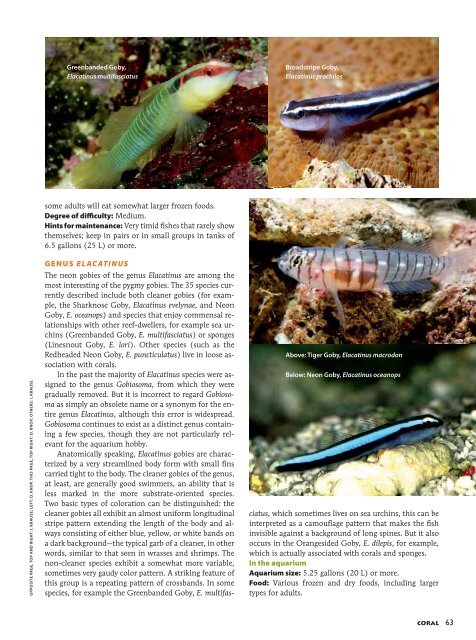You also want an ePaper? Increase the reach of your titles
YUMPU automatically turns print PDFs into web optimized ePapers that Google loves.
Greenbanded Goby,<br />
Elacatinus multifasciatus<br />
Broadstripe Goby,<br />
Elacatinus prochilos<br />
some adults will eat somewhat larger frozen foods.<br />
Degree of difficulty: Medium.<br />
Hints for maintenance: Very timid fishes that rarely show<br />
themselves; keep in pairs or in small groups in tanks of<br />
6.5 gallons (25 L) or more.<br />
OPPOSITE PAGE, TOP AND RIGHT: I. KRAUSE; LEFT: D. KNOP. THIS PAGE, TOP RIGHT: D. KNOP; OTHERS: I. KRAUSE<br />
GENUS ELACATINUS<br />
Above: Tiger Goby, Elacatinus macrodon<br />
Below: Neon Goby, Elacatinus oceanops<br />
The neon gobies of the genus Elacatinus are among the<br />
most interesting of the pygmy gobies. The 35 species currently<br />
described include both cleaner gobies (for example,<br />
the Sharknose Goby, Elacatinus evelynae, and Neon<br />
Goby, E. oceanops) and species that enjoy commensal relationships<br />
with other reef-dwellers, for example sea urchins<br />
(Greenbanded Goby, E. multifasciatus) or sponges<br />
(Linesnout Goby, E. lori). Other species (such as the<br />
Redheaded Neon Goby, E. puncticulatus) live in loose association<br />
with corals.<br />
In the past the majority of Elacatinus species were assigned<br />
to the genus Gobiosoma, from which they were<br />
gradually removed. But it is incorrect to regard Gobiosoma<br />
as simply an obsolete name or a synonym for the entire<br />
genus Elacatinus, although this error is widespread.<br />
Gobiosoma continues to exist as a distinct genus containing<br />
a few species, though they are not particularly relevant<br />
for the aquarium hobby.<br />
Anatomically speaking, Elacatinus gobies are characterized<br />
by a very streamlined body form with small fins<br />
carried tight to the body. The cleaner gobies of the genus,<br />
at least, are generally good swimmers, an ability that is<br />
less marked in the more substrate-oriented species.<br />
Two basic types of coloration can be distinguished: the<br />
cleaner gobies all exhibit an almost uniform longitudinal<br />
stripe pattern extending the length of the body and always<br />
consisting of either blue, yellow, or white bands on<br />
a dark background—the typical garb of a cleaner, in other<br />
words, similar to that seen in wrasses and shrimps. The<br />
non-cleaner species exhibit a somewhat more variable,<br />
sometimes very gaudy color pattern. A striking feature of<br />
this group is a repeating pattern of crossbands. In some<br />
species, for example the Greenbanded Goby, E. multifasciatus,<br />
which sometimes lives on sea urchins, this can be<br />
interpreted as a camouflage pattern that makes the fish<br />
invisible against a background of long spines. But it also<br />
occurs in the Orangesided Goby, E. dilepis, for example,<br />
which is actually associated with corals and sponges.<br />
In the aquarium<br />
Aquarium size: 5.25 gallons (20 L) or more.<br />
Food: Various frozen and dry foods, including larger<br />
types for adults.<br />
CORAL<br />
63

















